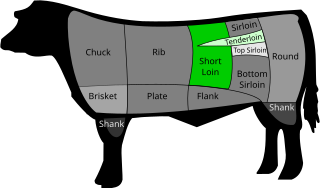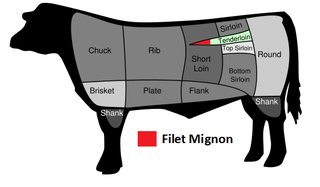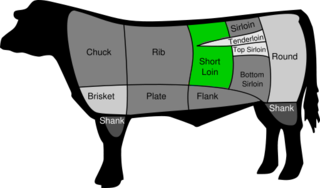Related Research Articles

A beefsteak, often called just steak, is a flat cut of beef with parallel faces, usually cut perpendicular to the muscle fibers. In common restaurant service a single serving has a raw mass ranging from 120 to 600 grams. Beef steaks are usually grilled, pan-fried, or broiled. The more tender cuts from the loin and rib are cooked quickly, using dry heat, and served whole. Less tender cuts from the chuck or round are cooked with moist heat or are mechanically tenderized.

The T-bone and porterhouse are steaks of beef cut from the short loin. Both steaks include a "T"-shaped lumbar vertebra with sections of abdominal internal oblique muscle on each side. Porterhouse steaks are cut from the rear end of the short loin and thus include more tenderloin steak, along with a large strip steak. T-bone steaks are cut closer to the front, and contain a smaller section of tenderloin. The smaller portion of a T-bone, when sold alone, is known as a filet mignon, especially if cut from the small forward end of the tenderloin.

Rodízio is an all-you-can-eat style of restaurant service in Brazilian restaurants with waiters bringing samples of food to each customer repeatedly throughout the meal, until the customers signal that they have had enough to eat.

A beef tenderloin, known as an eye fillet in Australasia, filet in France, filé mignon in Brazil, and fillet in the United Kingdom and South Africa, is cut from the loin of beef.

Filet mignon is a cut of meat taken from the smaller end of the tenderloin, or psoas major of a cow. In French, it mostly refers to cuts of pork tenderloin.

In American butchery, the sirloin steak is cut from the sirloin, the subprimal posterior to the short loin where the T-bone, porterhouse, and club steaks are cut. The sirloin is divided into several types of steak. The top sirloin is the most prized of these and is specifically marked for sale under that name. The bottom sirloin, which is less tender and much larger, is typically marked for sale simply as "sirloin steak". The bottom sirloin, in turn, connects to the sirloin tip roast.

The rib eye or ribeye is a boneless rib steak from the rib section.

The strip steak is a cut of beef steaks from the short loin of a cow. It consists of a muscle that does little work, the longissimus, making the meat particularly tender, although not as tender as the nearby psoas major or tenderloin. Unlike the tenderloin, the longissimus is a sizable muscle, allowing it to be cut into larger portions.
The loins, or lumbus, are the sides between the lower ribs and pelvis, and the lower part of the back. The term is used to describe the anatomy of humans and quadrupeds, such as horses, pigs, or cattle. The anatomical reference also applies to particular cuts of meat, including tenderloin or sirloin steak.

The tri-tip is a triangular cut of beef from the bottom sirloin subprimal cut, consisting of the tensor fasciae latae muscle. Untrimmed, the tri-tip weighs around 5 pounds. In the US, the tri-tip is taken from NAMP cut 185C.

A standing rib roast, also known as prime rib, is a cut of beef from the primal rib, one of the primal cuts of beef. While the entire rib section comprises ribs six through 12, a standing rib roast may contain anywhere from two to seven ribs.

During butchering, beef is first divided into primal cuts, pieces of meat initially separated from the carcass. These are basic sections from which steaks and other subdivisions are cut. Since the animal's legs and neck muscles do the most work, they are the toughest; the meat becomes more tender as distance from hoof and horn increases.

Short loin is the American name for a cut of beef that comes from the back of the cattle. It contains part of the spine and includes the top loin and the tenderloin. This cut yields types of steak including porterhouse, strip steak, and T-bone. The T-bone is a cut that contains less of the tenderloin than does the porterhouse. Webster's Dictionary defines it as "a portion of the hindquarter of beef immediately behind the ribs that is usually cut into steaks." The short loin is considered a tender beef.

Top sirloin is a cut of beef from the primal loin or subprimal sirloin. Top sirloin steaks differ from sirloin steaks in that the bone and the tenderloin and bottom round muscles have been removed; the remaining major muscles are the gluteus medius and biceps femoris.

A rib steak is a beefsteak sliced from the rib primal of a beef animal, with rib bone attached. In the United States, the term rib eye steak is used for a rib steak with the bone removed; however, in some areas, and outside the US, the terms are often used interchangeably. The "rib eye" or "ribeye" was originally, the central portion of the rib steak, without the bone, resembling an eye. The rib steak can also be prepared as a tomahawk steak which requires the butcher to leave the rib bone intact, french trim the bone and leave it at least five inches long. The tomahawk steak resembles the Native American tomahawk axe from which it gets its name.

The beef clod or shoulder clod is one of the least expensive cuts of beef and is taken from the shoulder (chuck) region of the animal. Beef clod is a large muscle system, with some fat that covers the muscles. The clod's composition is mainly three muscles: the shoulder tender, the top blade and the clod heart and is one of two chuck subprimal cuts. It is often divided into its three separate muscle cuts for retail sale.

Kansas City Steak Company based in Kansas City, Missouri, manufactures and markets premium beef, poultry, seafood, and other foods for foodservice and home delivery.

The cuts of pork are the different parts of the pig which are consumed as food by humans. The terminology and extent of each cut varies from country to country. There are between four and six primal cuts, which are the large parts in which the pig is first cut: the shoulder, loin, belly and leg. These are often sold wholesale, as are other parts of the pig with less meat, such as the head, feet and tail. Retail cuts are the specific cuts which are used to obtain different kinds of meat, such as tenderloin and ham. There are at least 25 Iberian pork cuts, including jamón.

A steak is a thick cut of meat generally sliced across the muscle fibers, sometimes including a bone. It is normally grilled or fried. Steak can be diced, cooked in sauce, such as in steak and kidney pie, or minced and formed into patties, such as hamburgers.

Baseball steak is a center cut of beef taken from the top sirloin cap steak. Baseball steaks differ from sirloin steaks in that the bone and the tenderloin and bottom round muscles have been removed; and the cut is taken from biceps femoris. A baseball steak is essentially a center cut top sirloin cap steak. This cut of beef is very lean, and is considered very flavorful.
References
- 1 2 Desimone, Tonina Leslie (Spring 2011). "NUTRIENT ANALYSIS OF THE BEEF ALTERNATIVE MERCHANDISING CUTS" (PDF). Colorado State University. Retrieved 2013-06-11.[ permanent dead link ]
- ↑ Cox, Ryan (2010-08-02). "New meat cuts provide affordable grilling alternatives". Ag News Wire. University of Minnesota Extension. Archived from the original on 2013-02-12. Retrieved 2013-06-11.
- ↑ Thornberry, Tim (June 4, 2013). "Kentucky Beef Council gets creative with cuts of meat to help consumers with rising prices". KyForward. Archived from the original on 2013-12-10. Retrieved 2013-06-11.
- 1 2 3 "Retail Training". Missouri Beef Industry Council. Archived from the original on 2012-07-31. Retrieved 2013-06-11.